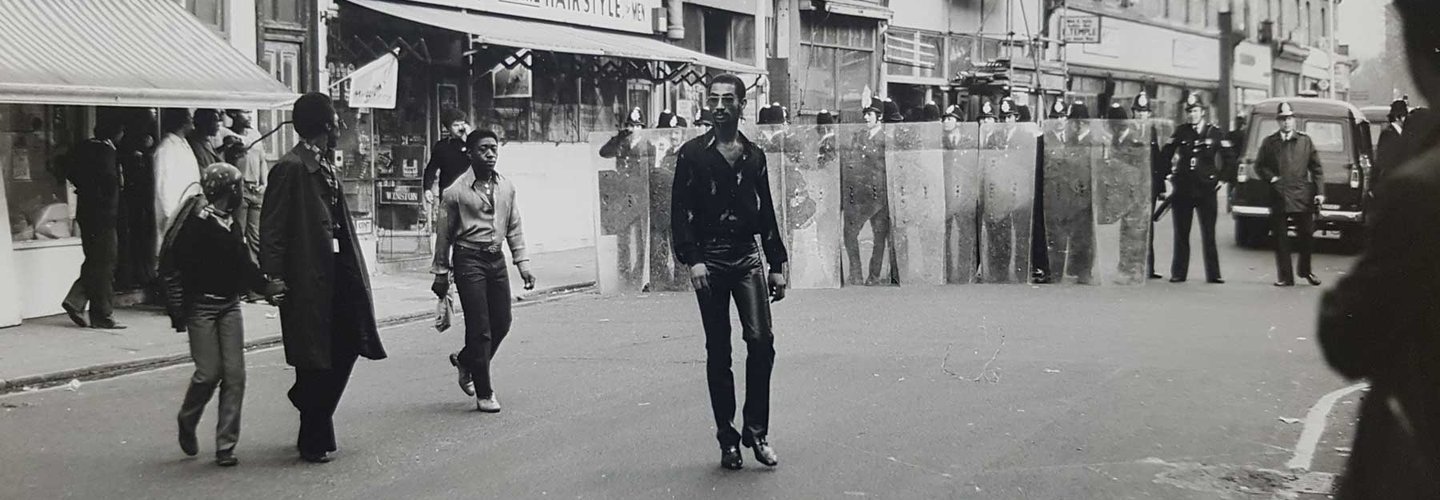Disorder in Brixton
On Friday 10 April 1981, against the backdrop of simmering tensions between Black communities and the police, a rumour began to circulate that officers were harassing a young Black man who’d been stabbed during an incident with two other youths. This led to a crowd gathering around them – and some projectiles being thrown – before the group began to disperse.
The following day, the situation erupted into scenes of violent disorder. Police searched a minicab driver for drugs (who turned out to be innocent), and when they then attempted to arrest a man who had joined a larger crowd of protestors, violent unrest broke out. This was described as the largest since the Second World War, continuing for three days.
Scarman’s documents
Two days after the disturbances ended, the UK Home Secretary commissioned Lord Justice Leslie Scarman – an experienced senior judge – to ‘inquire urgently into the serious disorder in Brixton on 10–12 April 1981 and to report, with the power to make recommendations’.
At The National Archives, we hold the evidence and papers Scarman used to write his report. We often hold documentation like this, that contributed to the creation of official or government papers and reports. As in this case, it often contains a wealth of material that did not make it into the final documents, which can be quite revealing.
-
- Title
- Evidence and papers from Lord Justice Scarman's inquiry
- Date
- 1981
For example, the file contains a leaflet entitled ‘Police and public: Complaints against the Police’. It ‘explains the procedure for members of the public who consider they have grounds for complaint against the conduct of a member of the police force.’
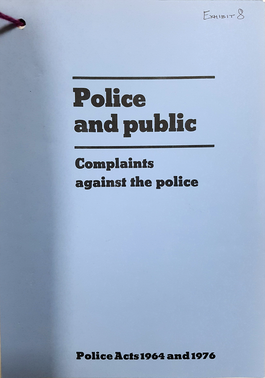
‘Police and public: Complaints against the Police’. Catalogue reference: Catalogue reference: HO 266/89
This hints at one of the key causes of the disturbances, which was the provocative policing of many officers in the area, particularly under what was called ‘Operation Swamp 81.’
‘Swamp’ or ‘swamped’ was a particularly loaded term at the time, as it had previously been employed by Margaret Thatcher, then Prime Minister, to describe immigration. Used here, it suggested the policing strategy – 'swamping' Brixton with extra officers.
Under the campaign, police used their powers to stop and search Brixton residents in large numbers. This was done using the 'sus laws' (shorthand for ‘suspicious behaviour’), which were rooted in the 1824 Vagrancy Act but had been revived in the 1970s to police inner city youth. These laws allowed officers to stop and search citizens merely on the basis of suspicion that they intended to commit a crime, rather than needing a burden of proof. In Brixton, the police targeted young Black people in disproportionate numbers.
A visual record of events
The file contains various photographs that provide a powerful visual record of the disturbances, giving, for instance, a striking insight into the damage caused.
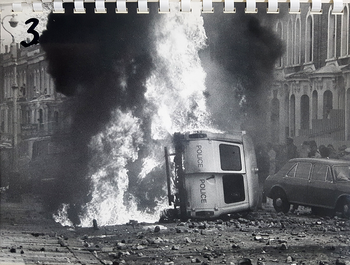
Photograph of a destroyed police van during the disturbances. Catalogue reference: HO 266/89
They vividly capture the violence on Saturday 11 April, the high point of the disturbance. On that day:
- 82 arrests were made
- 279 police officers and 45 members of the public were reported injured
- 117 vehicles were damaged or destroyed, including 56 police vehicles
- 145 properties were damaged.
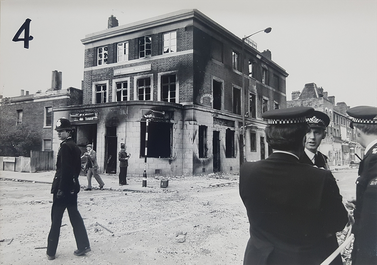
Photograph of a burnt out pub. Catalogue reference: HO 266/89
Among Scarman's papers are maps recording which specific properties were damaged:
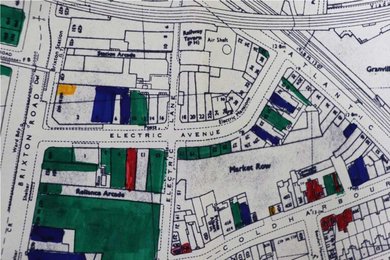
Map of Brixton depicting damage to property in and around Electric Avenue. Catalogue reference: HO 266/89
Photographs also provide an insight into police tactics. There is evidence of what has been called the militarisation of the police – the authorities’ use of military equipment and tactics, which might have previously been used in Britain’s colonies, to police its inner-cities.
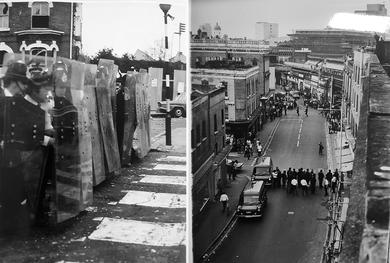
Photographs of police lines during the events. Catalogue reference: HO 266/89
Community perspectives
As the official archive of the UK government, The National Archives' records tend to represent the voice of the state. However, they can contain important documents from other sources, such as those deemed relevant to investigations or inquiries at the time.
This press release from the Council for Community Relations in Lambeth offers a community perspective on what happened in Brixton:
CCRL sees the events of last weekend as the inevitable result of long standing and consistently provocative policing policies in the area. This combined with persistent official neglect of the community [...] meant that the weekend's violence was the only way people could express legitimate resentment at persistent injustice.
[...]
We sympathise with those in the community who have suffered through the violence and fear of the weekends events, but this is only the most publicised incident in a whole history of community suffering.
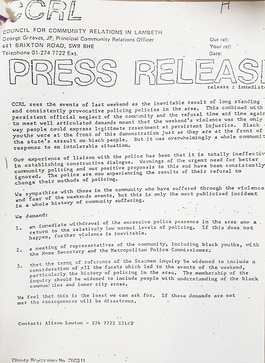
Partial transcript
[...]
Black youths were at the front of this demonstration just as they are at the front of the state's assault on black people. But it was overwhelmingly a whole community response to an intolerable situation.
Our experience of liaison with the police has been that it is totally ineffective in establishing constructive dialogue. Warnings of the urgent need for better community policing and our positive proposals to this end have been consistently ignored. The police are now experiencing the results of their refusal to change their methods of policing.
[...]
We demand:
- An immediate withdrawal of the excessive police presence in the area and a return to the relatively low normal levels of policing. if this does not happen, further violence inevitable.
- A meeting of representatives of the community, including black youths, with the Home Secretary and the Metropolitan Police Commissioner.
- The the terms of reference of the Scarman inquiry be widened to include a consideration of all the facets which led to the events of the weekend, particularly the history of policing in the area. The membership of the inquiry should be widened to include people with understanding of the black communities and inner city areas.
We feel that this is the least we can ask for. If these demands are not met the consequences will be disastrous.
[...]
Black youths were at the front of this demonstration just as they are at the front of the state's assault on black people. But it was overwhelmingly a whole community response to an intolerable situation.
Our experience of liaison with the police has been that it is totally ineffective in establishing constructive dialogue. Warnings of the urgent need for better community policing and our positive proposals to this end have been consistently ignored. The police are now experiencing the results of their refusal to change their methods of policing.
[...]
We demand:
- An immediate withdrawal of the excessive police presence in the area and a return to the relatively low normal levels of policing. if this does not happen, further violence inevitable.
- A meeting of representatives of the community, including black youths, with the Home Secretary and the Metropolitan Police Commissioner.
- The the terms of reference of the Scarman inquiry be widened to include a consideration of all the facets which led to the events of the weekend, particularly the history of policing in the area. The membership of the inquiry should be widened to include people with understanding of the black communities and inner city areas.
We feel that this is the least we can ask for. If these demands are not met the consequences will be disastrous.
Press release from the Council for Community Relations in Lambeth. Catalogue reference: HO 266/89
It’s important to note, however, that many community groups such as The Brixton Defence Campaign (which was established to support those arrested in relation to the disorder) boycotted the inquiry altogether. They thought it would be a whitewash, meaning that it would effectively absolve the police of any wrongdoing, and evidence submitted would be used against Black defendants.
The records of The Brixton Defence Campaign are held at The Black Cultural Archives in Brixton – a reminder of how important it is to visit a range of archives to build a rounded picture of events.
The report's findings
Lord Scarman published his report on 25 November 1981. Famously, it argued that the disorder in Brixton emerged out of social and economic disadvantage.
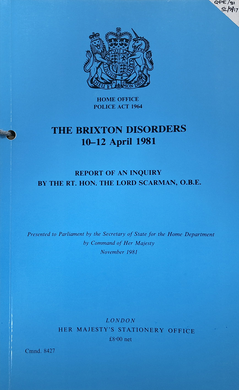
Cover of Lord Scarman's finished report, November 1981. Catalogue reference: HO 325/420
The evidence which I have received [...] leaves no doubt in my mind that racial disadvantage is a fact of current British life. It was, I am equally sure, a significant factor in the causation of the Brixton disorders. [...] "Institutional racism" does not exist in Britain : but racial disadvantage and its nasty associate racial discrimination, have not yet been eliminated.
[...]
The attack on racial disadvantage must be more direct than it has been. It must be co-ordinated by central government, who with local authorities must ensure that the funds made available are directed to specific areas of racial disadvantage. I have in mind particularly education and employment.
Extracts from the conclusion of Lord Scarman's report
-
- Title
- The Scarman Report
- Date
- November 1981
The report was criticised, however, for downplaying accusations of police misconduct and taking the position that institutional racism did not exist in Britain.
Eighteen years later the Macpherson Report, which followed the botched investigation into the racist murder of Stephen Lawrence, would highlight the same issues. It came to a different conclusion: that institutional racism exists 'in the Metropolitan Police Service and in other Police Services and other institutions countrywide'.
The Brixton riots (or uprisings) weren’t the first incidents of disorder or protest in London or on Britain’s streets, and neither were they the last. In 2011, for example, the England riots (also known as the London riots) began in North London and spread across the city and the country – including to Brixton, 30 years on.
